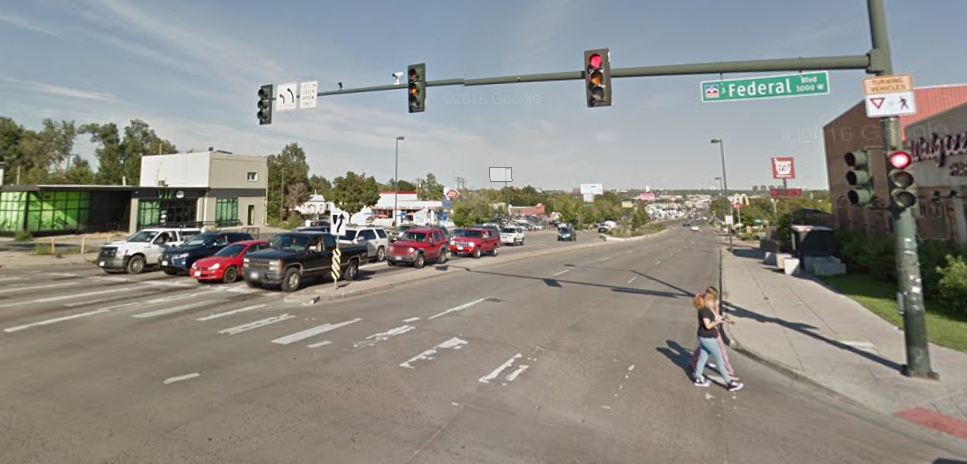How Will Public Works Fix Everything That’s Wrong With Federal Boulevard?

Federal Boulevard is one of the deadliest streets in the city, especially if you’re walking. But it could be so much better. Federal is already full of foot traffic, it carries more transit passengers than all but one other street in the city, and it could serve as an incredibly direct and useful bike route. If only it weren’t designed solely to move motor vehicle traffic.
Denver Public Works is embarking on a project with the potential to transform a nine-mile stretch of Federal from a car-first urban highway to a street that works for people.
DPW’s Federal Boulevard Corridor Wide Study will cover the area from Floyd Avenue to Columbine Road. At a meeting last Thursday, city planners and consultants laid out what’s wrong with Federal and asked people how they would solve those problems. (It’s too early in the process for specific design solutions, and money hasn’t been allocated for those yet, but you can weigh in and tell the city how you want to change the street.)
Gosia Kung, executive director of WalkDenver, said she wants to see a new street design that cuts driving speeds dramatically.
“We heard concerns about road racing and cruising, but we can design Federal Boulevard to where racing is not possible simply by the nature of the design of the street,” she said. “Is that the priority? If the speed is significantly lower, the likelihood of anybody dying on Federal Boulevard is much lower. So do we have political will to lower the speed on Federal? Are crashes just the cost of doing business because we have to provide a certain level of service for people to drive? Or are no crashes acceptable?”
There’s reason to be skeptical. On a different stretch of Federal, DPW plans to widen the road despite the higher traffic speeds and threat to public safety that will result.
Still, safety was the word at Thursday’s meeting, and DPW presented eye-opening information that clearly indicated the design of the street needs to change. Here are the major takeaways.

Federal is a crucial street for pedestrians, but isn’t a safe place to walk. Federal Boulevard is full of destinations: Two high schools, two universities, health centers, too many restaurants and stores to count, some supermarkets, Mile High Stadium, and a mix of apartments and single-family homes. As a result, it’s the city’s second-busiest transit corridor and gets a ton of foot traffic.
Despite all that pedestrian activity, the street is not built for people on foot:
- Between 2010 and 2015, there were 4,465 traffic crashes on this stretch of Federal, or about three per day. While there were many more car-only crashes than crashes involving bike riders and pedestrians, people outside of cars are most at risk of getting killed. Of the 13 people killed on Federal in that time frame, nine were pedestrians.
- Federal is wide. On a street with posted speed limits of 35 and 40 mph, wide lanes encourage even higher speed. Lanes range from 10 feet wide (a safe width for urban streets) to an alarming 16 feet. Pedestrian crossing distances range from 78 feet to 96 feet.
- At some points, the distance between signalized crosswalks is about half a mile — or a 10-minute walk for the average person. And people wonder why pedestrians cross mid-block.
- 45 percent of Federal’s sidewalks butt right up against traffic, with no buffer. 4 percent of Federal doesn’t have sidewalks at all.
- Street racing is a huge problem. It’s so serious that the Denver Police Department has a force dedicated solely to Federal and its surrounding streets.
Federal is a crucial transit corridor, but it’s not built for transit. On an average weekday, people make 13,600 bus trips on Federal. Only Colfax gets more. Federal has seven bus lines, two major bus hubs — one at Evans, one at Colfax — and the Federal-Decatur light rail station on the W-Line.
Despite all those transit trips, the street does not prioritize buses carrying dozens of people more than single-occupancy cars. There’s no dedicated bus lane, traffic signals don’t prioritize buses, and bus stops aren’t always spaced efficiently. That leads to slow bus speeds — as low as 6.3 mph during afternoon rush hour. Many bus stops — 39 percent — have no bench or shelter, just a sign. On Federal, transit doesn’t work well for the people who ride it and needs some serious improvements if it’s going to attract new passengers.
While it’s too early to say what the fix will be, Federal will be a crucial subject of DPW’s upcoming intra-city transit plan, said Kristina Evanoff, who is heading that effort.
Biking is an afterthought on Federal. That’s no surprise to anyone. According to DPW, Federal “dead-ends, diverts, or changes drastically in character for bicyclists.” There aren’t any bike lanes on the street, and drivers travel too fast for almost anyone to bike in traffic. DPW plans to install bikeways on nearby 2nd Avenue, Knox Court, 29th Avenue, and 35th Avenue this year, but there is no substitute for the continuity and connectivity that a bike lane on Federal would provide.
DPW officials say they want to settle on a plan to improve Federal before trying to fund it. If you want to make Federal more of a street for people and less of an urban highway, you can tell DPW via an online survey or by emailing the people working on the project.


